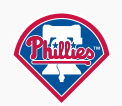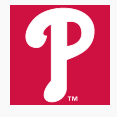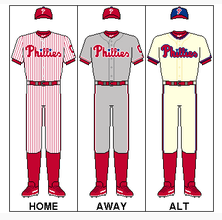
Philadelphia Phillies
USINFO | 2013-06-20 11:32
| Philadelphia Phillies | |||||
| 2013 Philadelphia Phillies season | |||||
| Established | 1883 | ||||
|
|||||
| Major league affiliations | |||||
|
National League (1883–present) East Division (1969–present) |
|||||
| Current uniform | |||||
|
|||||
| Retired numbers | 1 · 14 · 20 ·32 · 36 · 42 ·P · P | ||||
| Colors | |||||
|
Red, white, blue |
|||||
| Name | |||||
| Philadelphia Phillies (1883–present) | |||||
| Philadelphia Quakers (1883–1889) | |||||
| Other nicknames | |||||
| Phils, The Fightin' (or Phightin') Phils, The Fightin's (or Phightin's) | |||||
| Ballpark | |||||
|
Citizens Bank Park (2004–present) Veterans Stadium (1971–2003) Connie Mack Stadium (1927, 1938–1970) a.k.a. Shibe Park (1938–1952) Baker Bowl (1887–1938) a.k.a. National League Park (1895–1913) a.k.a. Philadelphia Base Ball Grounds (1887–1895) Recreation Park (1883–1886) |
|||||
| Major league titles | |||||
| World Series titles (2) | 2008 · 1980 | ||||
| NL Pennants (7) | 2009 · 2008 ·1993 · 1983 ·1980 · 1950 · 1915 | ||||
| East Division titles (11) | 2011 · 2010 ·2009 · 2008 ·2007 · 1993 ·1983 · 1980 ·1978 · 1977 · 1976 | ||||
| Wild card berths (0) | |||||
| Front office | |||||
| Owner(s) |
David Montgomery(managing partner), Giles Limited Partnership (Bill Giles), Claire S. Betz, Tri-Play Associates (William C. Buck), Double Play Inc. (John S. Middleton)[1] |
||||
| Manager | Charlie Manuel | ||||
| General Manager | Rubén Amaro, Jr. | ||||
The Philadelphia Phillies are a Major League Baseball team. They are the oldest continuous, one-name, one-city franchise in all of professional American sports, dating to 1883.[2] The Phillies are a member of the Eastern Division of Major League Baseball's National League. Since 2004, the team's home has been Citizens Bank Park in the South Philadelphia section of the city.
The Phillies have won two World Series championships (against Kansas City in 1980 and Tampa Bay in 2008) and seven National League pennants, the first of which came in 1915. The franchise has also experienced long periods of struggle. Once the modern World Series began in 1903, it took the Phillies 77 years from that point (and 97 years from the club's establishment) to win their first World Series—longer than any other of the 16 teams that made up the major leagues for the first half of the 20th century. The 77 years of drought is the fourth longest World Series drought in Major League Baseball history. The longevity of the franchise and its history of adversity have earned it the dubious distinction of having lost the most games of any team in the history of American professional sports.[3] Notwithstanding the collectively poor performance over the years, the Phillies have performed much better in recent seasons, winning five consecutive division titles from 2007 through 2011.
The franchise was founded in Philadelphia in 1883, replacing the team from Worcester, Massachusetts in the National League. The team has played at several stadiums in the city, beginning withRecreation Park and continuing at Baker Bowl; Shibe Park, which was later renamed Connie Mack Stadium in honor of the longtime Philadelphia Athletics manager; Veterans Stadium; and nowCitizens Bank Park.
The team's spring training facilities are located in Clearwater, Florida, where its Class-A minor league affiliate Clearwater Threshers play at Bright House Field. Its Double-A affiliate is the Reading Fightin Phils, which plays in Reading, Pennsylvania, and its Triple-A affiliate is the Lehigh Valley IronPigs, which plays in Allentown, Pennsylvania.
History
Main article: History of the Philadelphia Phillies
Early history
See also: 1915 World Series
After being founded in 1883 as the "Quakers", the team changed its name to the "Philadelphias", after the convention of the times. This was soon shortened to "Phillies".[4] "Quakers" continued to be used interchangeably with "Phillies" from 1884 until 1890, when the team officially became known as the "Phillies". Though the Phillies moved into a permanent home at Baker Bowl in 1887,[2] they did not win their first pennant until nearly 30 years later, after the likes of standout players Billy Hamilton, Sam Thompson, and Ed Delahanty had departed. Player defections to the newly-formed American League, especially to the cross-town Athletics, would cost the team dearly over the next several years. A bright spot came in 1915, when the Phillies won their first pennant, thanks to the pitching of Grover Cleveland Alexander and the batting prowess of Gavvy Cravath, who set what was then the modern major-league single-season record for home runs with 24.[5] Poor fiscal management after their appearance in the 1915 World Series, however, doomed the Phillies to sink back into relative obscurity; from 1918 to 1948 they only had one winning season. Though Chuck Klein won the Most Valuable Player Award in 1932 and the National League Triple Crown in 1933, the team continued to flounder at the bottom of the standings for years.[6]
Cox, Carpenter, and the "Whiz Kids" era
See also: Whiz Kids (baseball) and 1950 World Series
After lumber baron William B. Cox purchased the team in 1943, the Phillies began a rapid rise to prominence in the National League, as the team rose out of the standings cellar for the first time in five years. As a result, the fan base and attendance at home games increased. But it soon became clear that not all was right in Cox's front office. Eventually, it was revealed by Cox that he had been betting on the Phillies and he was banned from baseball. The new owner, Bob Carpenter, Jr., scion of the Delaware-based DuPont family, tried to polish the team's image by unofficially changing its name to the "Bluejays". However, the new moniker did not take, and it was quietly dropped by 1949.[7]
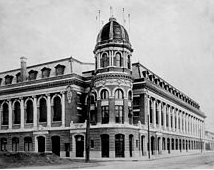
Instead, Carpenter turned his attention to the minor league affiliates, continuing an effort begun by Cox a year earlier; prior to Cox's ownership, the Phillies had paid almost no attention to player development. This led to the advent of the "Whiz Kids," led by a lineup of young players developed by the Phillies' farm system that included future Hall of Famers Richie Ashburnand Robin Roberts.[8] Their 1950 season was highlighted by a last-day, pennant-clinching home run by Dick Sisler to lead the Phillies over the Dodgers and into the World Series.[9]Comparatively, the Athletics finished last in 1950 and longtime Manager Connie Mack retired. The A's would struggle on for four more years with only one winning team, and then abandon Philadelphia (under the Johnson brothers, who bought out Mack) and start play in Kansas City in 1955.[10]
From lows to highs
See also: 1964 Philadelphia Phillies season, 1980 World Series, and 1983 World Series
The Phillies sank back to mediocrity during the mid-1950s after the departure of the "Whiz Kids", their competitive futility culminating in a record that still stands: in 1961, the Phillies lost 23 games in a row (a record since 1900). But from this nadir bright spots began to appear. Though Ashburn and Roberts were gone, younger pitchers Art Mahaffey, Chris Short, and rookie Ray Culp; veterans Jim Bunning and screwballer Jack Baldschun; and fan favorites Cookie Rojas, Johnny Callison, and NL Rookie of the Year Richie Allen brought the team within a hairsbreadth of the World Series in 1964 after strong showings in 1962 and 1963. However, the Phillies squandered a six-and-a-half-game lead during the final weeks of the season that year, losing 10 games in a row with 12 games remaining and losing the pennant by one game to the St. Louis Cardinals. The "Phold of '64" is among the most notable collapses in sports history.[11] One highlight of the season occurred on Father's Day, when Jim Bunning pitched a perfect game against the New York Mets, the first in Phillies history.
At the end of the decade, in October 1970, the Phillies played their final game in Connie Mack Stadium and prepared to move into newly built Veterans Stadium, wearing new maroon uniforms to accentuate the change. While some members of the team performed admirably during the 1970s, the Phillies still clung to their position at the bottom of the National League standings. Ten years after "the Phold", they suffered another minor collapse in August and September 1974, missing out on the playoffs yet again. But the futility would not last much longer. After a run of three straight division titles from 1976 to 1978,[12] the Phillies won the NL East in 1980 behind pitcher Steve Carlton, outfielder Greg Luzinski, and infielders Mike Schmidt, Larry Bowa, and Pete Rose. In a memorable NLCS, with four of the five games going into extra innings, they fell behind 2–1 but battled back to squeeze past the Houston Astroson a tenth-inning, game-winning hit by center fielder Garry Maddox, and the city celebrated its first pennant in 30 years.[13]
Facing the Kansas City Royals in the 1980 World Series, the Phillies won their first World Series championship ever in six games thanks to the timely hitting of Mike Schmidt and Pete Rose. Schmidt, who was the National League MVP that 1980 season, also won the World Series MVP award on the strength of his 8-for-21 hitting (.381 average), including game-winning hits in Game 2 and the clinching Game 6. Thus, the Phillies became the last of the 16 teams that made up the major leagues from 1901 to 1961 to win a World Series.[14] The Phillies made the playoffs twice more in the 1980s[15] after their Series win, in 1981 and 1983, where they lost to the Baltimore Orioles in the World Series, but they would soon follow these near-misses with a rapid drop back into the basement of the National League.[13] The 1992 season, for example, would end with the Phillies in last place in the National League East. But their fortunes were about to change.
Recent history
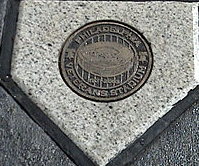
See also: 1993 World Series, 2008 World Series, 2009 World Series, and 2012 Philadelphia Phillies season
The 1993 Phillies started the season by going 17–5 in April and finishing with a 97–65 season. The Phillies beat the Atlanta Braves in the 1993 National League Championship Series, four games to two, to earn the fifth pennant in franchise history, only to be defeated by the defending league champion Toronto Blue Jays in the 1993 World Series.[16] Toronto's Joe Carter hit a walk-off home run in Game 6 to clinch another Phillies loss.[17] The 1994–95 Major League Baseball strike was a blow to the Phillies' attendance and on-field success, as was the arrival of the Braves in the division due to league realignment. Several stars came through Philadelphia, though few would stay, and the minor league system continued to develop its young prospects, who would soon rise to Phillies fame.
In 2001, the Phillies had their first winning season in eight years under new manager Larry Bowa, and their season record would not dip below .500 again from the 2003 season onward.[18] In 2004, the Phillies moved to their new home, Citizens Bank Park,[19] across the street from the Vet.
Charlie Manuel took over the reins of the club from Bowa after the 2004 season, and general manager Ed Wade was replaced by Pat Gillick in November 2005. Gillick reshaped the club as his own, sending stars away in trades and allowing the Phillies' young core to develop. After the franchise lost its 10,000th game in 2007,[3] its core of young players, including infielders Chase Utley, Ryan Howard, andJimmy Rollins and pitcher Cole Hamels, responded by winning the National League East division title, but they were swept by the Colorado Rockies in the Division Series.[20] After the 2007 season, they acquired closer Brad Lidge.
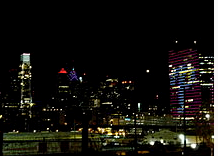
In 2008, the Phillies clinched their second straight division title[21] and defeated the Milwaukee Brewers in the Division Series to record the franchise's first post-season victory since winning the 1993 NLCS. Behind strong pitching from the rotation and stellar offensive production from virtually all members of the starting lineup, the Phillies won the 2008 National League Championship Series against the Los Angeles Dodgers; Hamels was named the series' Most Valuable Player. The Phillies would then go on to defeat the Tampa Bay Raysin 5 games for their second World Series title in their 126-year history. Hamels was named both NLCS MVP as well as World Series MVP after going 4–0 in the postseason that year.
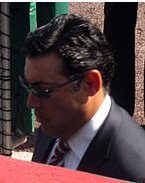
Gillick retired as general manager after the 2008 season and was succeeded by one of his assistants, Ruben Amaro, Jr. After adding outfielder Raúl Ibañez to replace the departed Pat Burrell, the Phillies retained the majority of their core players for the 2009 season. In July, they signed three-time Cy Young Award winner Pedro Martinez and acquired 2008 American League Cy Young winner Cliff Lee before the trade deadline. On September 30, 2009, they clinched a third consecutive National League East Division title for the first time since the 1976–78 seasons. The team continued this run of success with wins over the Colorado Rockies in the NLDS (3 games to 1) and the Los Angeles Dodgers in the NLCS (4 games to 1), to become the first Phillies team to win back-to-back pennants and the first National League team since the 1996 Atlanta Braves to have an opportunity to defend their World Series title. The Phillies were unable to repeat, falling to the New York Yankees, 4 games to 2. Nevertheless, in recognition of the team's recent accomplishments, Baseball America named the Phillies as its Organization of the Year.[22]
On December 16, 2009, they acquired starting pitcher Roy Halladay from the Toronto Blue Jays for three minor-league prospects,[23] and traded Cliff Lee to the Seattle Marinersfor three prospects.[24] On May 29, 2010, Halladay pitched a perfect game against the Florida Marlins.[d]
In June 2010, the team's scheduled 2010 series against the Toronto Blue Jays at Rogers Centre was moved to Philadelphia, because of security concerns for the G-20 Summit. The Blue Jays wore their home white uniforms and batted last as the home team, and the designated hitter was used.[25] The game was the first occasion of the use of a designated hitter in a National League ballpark in a regular-season game; Ryan Howard was the first player to fill the role.[26]
The 2010 Phillies won their fourth consecutive NL East Division championship[15][27] despite a rash of significant injuries to key players, including Ryan Howard,[28] Chase Utley,[29] Jimmy Rollins,[30] Shane Victorino,[31] and Carlos Ruiz.[32] After dropping seven games behind the Atlanta Braves on July 21, Philadelphia finished with an MLB-best record of 97–65.[33] The streak included a 20–5 record in September, the Phillies' best September since winning 22 games that month in 1983,[34] and a 11–0 run in the middle of the month.[35] The acquisition of pitcher Roy Oswalt in early August was a key step, as Oswalt won seven consecutive games in just over five weeks from August 11 through September 17.[35] The Phillies clinched the division on September 27, behind a two-hit shutout by Halladay.[36]
In Game 1 of the 2010 National League Division Series, Halladay threw the second no-hitter in Major League baseball postseason history, leading the Phillies over the Cincinnati Reds, 4–0. The first no-hitter in postseason history was New York Yankee pitcher Don Larsen's perfect game in the 1956 World Series.[37] Halladay's no-hitter was the fifth time a pitcher has thrown two no-hitters in the same season, and was also the first time that one of the two occurred in the postseason. The Phillies went on to sweep the Reds in three straight games. In the 2010 National League Championship Series, the Phillies fell to the eventual World Series champion San Francisco Giants in six games.
On September 17, 2011, the Phillies won their fifth consecutive East Division championship,[38] and on September 28, during the final game of the season, the team set a franchise record for victories in a season with 102 by beating theAtlanta Braves in 13 innings, denying their division rivals a potential Wild Card berth.[39] Yet the Phillies lost in the NLDS to the St. Louis Cardinals – the team that won the National League Wild Card as a result of the Phillies beating the Braves. The Cardinals subsequently beat the Brewers in the NLCS and won the 2011 World Series in 7 games.
The 2012 Phillies experienced an up and down season. They played .500 ball through the first two months, but then slumped through a 9–19 stretch in June where they ended up at the bottom of the NL East by midseason. With any hope dimming, the Phillies traded key players Shane Victorino and Joe Blanton to the Los Angeles Dodgers, and Hunter Pence to the San Francisco Giants before the trade deadline. However, a hot start in the second half of the season put the Phillies back on the postseason hunt, though any hope was eventually extinguished with a loss to the Washington Nationals on September 28, thus the Phillies missed the postseason for the first time since 2006.
Team uniform
See also: Major League Baseball uniforms
See footnotes[40][41]
Current uniform
The current team colors, uniform, and logo date to 1992. The main team colors are red and white, with blue serving as a prominent accent. The team name is written in red with a blue star serving as the dot over the "i"s, and blue piping is often found in Phillies branded apparel and materials. The team's home uniform is white with red pinstripes, lettering and numbering. The road uniform is traditional grey with red lettering/numbering. Both bear a script-lettered "Phillies" logo, with the aforementioned star dotting the "i"s across the chest, and the player name and number on the back. Hats are red with a single stylized "P".[42] The uniforms and logo are very similar to those used during the "Whiz Kids" era from 1950 to 1969.
Along with its National League compadres, the St. Louis Cardinals, the Phillies are one of two teams in Major League baseball which utilize chain stitching in its chest emblem.
In 2008, the Phillies introduced an alternate, cream-colored uniform during home day games in tribute to their 125th anniversary. The uniforms are similar to those worn from 1946 through 1949, featuring red lettering bordered with blue piping and lacking pinstripes.[43] The accompanying cap is blue with a red bill and a red stylized "P." The uniforms were announced on November 29, 2007, when Phillies shortstop Jimmy Rollins, pitcher Cole Hamels, and Hall of Fame pitcherRobin Roberts modeled the new uniforms.[44]
For the 2009 season the Phillies added black, circular "HK" patches to their uniforms over their hearts in honor of broadcaster Harry Kalas, who died April 13, 2009, just before he was to broadcast a Phillies game. From Opening Day through July 26, 2009, the Phillies wore 2008 World Champions patches on the right sleeve of their home uniforms. In 2010, the Phillies added a black patch with a white "36" on the sleeves of their jerseys to honor Roberts, who died on May 6. Roberts' No. 36 had been previously retired by the team. In 2011, the Phillies added a black circular patch with a 'B' in honor of minority owners Alexander and John Buck, who died in late 2010.
The Phillies are one of four teams in Major League Baseball that do not display the name of their city, state, or region on their road jerseys, joining the Los Angeles Angels of Anaheim, St. Louis Cardinals, and the Tampa Bay Rays. The Phillies are the only team that also displays the player's number on one sleeve except on the alternate jersey, in addition to the usual placement on the back of the jersey.
Batting practice
The Phillies were an early adopter of the batting practice jersey in 1977, wearing a maroon v-necked top with the "Phillies" script name across the chest, as well as the player name and number on the back and a player number on the left sleeve, all in white. Larry Bowa, Pete Rose, and Mike Schmidt wore this maroon batting jersey in place of their road jersey during the 1979 All-Star Game in Seattle. Currently, during spring training, the Phillies wear solid red practice jerseys with pinstriped pants for Grapefruit League home games. The red jerseys are worn with grey pants on the road.
Former uniforms
See also: List of Philadelphia Phillies turn back the clock games
From 1970 to 1991, the Phillies sported colors, uniforms, and a logo that were noticeably different from what had come before, or since, but that were widely embraced by even traditionally minded fans. A dark burgundy was adopted as the main team color, with a classic pinstripe style for home uniforms. Blue was almost entirely dropped as part of the team's official color scheme, except in one area; a pale blue (as opposed to traditional grey) was used as the base-color for away game uniforms. Yet the most important aspect of the 1970 uniform change was the adoption of one of the more distinctive logos in sports; a Phillies "P" that, thanks to its unique shape and "baseball stitched" center swirl, remained instantly recognizable and admired, long after its regular use had ended. It was while wearing this uniform style and color motif that the club achieved its most enduring success, including a World Series title in 1980 and another World Series appearance in 1983.[42] Its continued popularity with fans is still evident, as even today Phillies home games can contain many fans sporting caps, shirts, and/or jackets emblazoned with the iconic "P" and burgundy color scheme. The current Phillies team has worn the burgundy and powder blue throwbacks whenever their opponents are wearing throwback uniforms from that era.
Controversial uniform changes
In 1979, the Phillies front office modified the uniform into an all-burgundy version with white trimmings, to be worn for Saturday games.[45] They were called "Saturday Night Specials", in a derisive nod to cheap handguns then called by that name and were worn for the first and last time on May 19, 1979,[46] a 10–5 loss to the Expos.[47] The immediate reaction of the media, fans, and players alike was negative, with many describing the despised uniforms as pajama-like. As such, the idea was hastily abandoned.[48] Mike Schmidt did wear the uniform during the MLB All-Star Tour of Japan following the 1979 season. The final appearance on field (to date) of this uniform was during the closing ceremonies atVeterans Stadium on September 28, 2003. There was a rather large procession of players during the post game ceremony, most in uniform. Former pitcher Larry Christenson, the starting pitcher in the original game, came out wearing this old burgundy uniform, and was the only one to do so.
Another uniform controversy arose in 1994 when the Phillies introduced blue caps on Opening Day which were to be worn for home day games only.[49] The caps were unpopular with the players, who considered them bad luck after two losses. The caps were dumped after being used on the field for a month. A different blue cap was introduced in 2008 as part of the alternate home uniform for day games, a throwback to the late 1940s.
Community
See also: Philadelphia Phillies' environmental record
Charitable contributions
The Phillies have supported amyotrophic lateral sclerosis research (also known as Lou Gehrig's disease) with the "Phillies Phestival" since 1984.[85] The team raised over US$750,000 for ALS research at their 2008 festival, compared with approximately $4,500 at the inaugural event in 1984;[85] the event has raised a total of over $10 million in its history.[86] The ALS Association of Philadelphia is the Phillies' primary charity,[87] and the hospitals they support includePennsylvania Hospital, Thomas Jefferson University Hospital, and Hahnemann University Hospital.[85] Former Phillies pitchers Geoff Geary, now with the Houston Astros and who lost a friend to the disease,[88] and Curt Schilling, who retired with the Boston Red Sox,[89] are both still involved with the Phillies' cause.
Phanatic about Education
The Philadelphia Phillies have shown to be a big supporter of reading and overall education. The Phillies want to use baseball in a positive way to help support education for students. The Phillies have a reading incentive program called PhanaticAbout Reading which is designed to encourage students from kindergarten to eighth grade to read for a minimum of 15 minutes a night. This reading program is to help students with their literacy skills and comprehension. Phillies Phundamentals is another educational program that is designed to make learning fun and support academic skills by using baseball. This program is offered through after school and summer camps.
The Phillies club will celebrate teachers during the 12th Annual Teacher Appreciation Night.
Fan support

See footnote[90]
Phillies fans have earned a reputation over the years for their occasional unruly behavior. In the 1960s, radio announcers for visiting teams would frequently report on the numerous fights breaking out inConnie Mack Stadium.[citation needed] Immediately after the final game at the old park, many fans ran onto the field or dislodged parts of the ballpark to take home with them.[91] Later, at Veterans Stadium, the 700 Level gained a reputation for its "hostile taunting, fighting, public urination and general strangeness."[92]
Phillies fans are known for harsh criticism of their own stars such the 1964 Rookie of the Year Richie Allen and Hall of Fame third baseman Mike Schmidt. The fans, however, are just as well known for heckling the visiting team. Los Angeles Dodgers pitcher Burt Hooton's poor performance during game three of the 1977 National League Championship Series[93] has often been attributed to the crowd's taunting.[citation needed] J. D. Drew, the Phillies' first overall draft pick in the amateur draft of 1997, never signed with the Phillies following a contract dispute with the team, instead re-entering the draft the next year to be drafted by the St. Louis Cardinals.[94] Phillies fans were angered over this disrespect and debris, including two D batteries, was hurled at Drew during an August 1999 game.[95]Subsequent visits by Drew to Philadelphia continue to be met with sustained booing from the Phillies fans.
Many sports writers have noted the passionate presence of Phillies fans, including Allen Barra, who wrote that the biggest roar he ever heard from Philadelphia fans was in 1980 when Tug McGraw, in the victory parade after the World Series, told New York fans they could "take this championship and shove it."[96]
When the Phillies moved to Veteran's Stadium, they hired a group of young ladies to serve as ushers. These women wore maroon-colored outfits featuring hot pants and were called the Hot Pants Patrol.[97] The team also introduced a pair of mascots, attired in colonial garb and named Philadelphia Phil and Phyllis. In addition to costumed characters, animated Phil and Phylis figures mounted on the center field facade would "hit" the Liberty Bell after a Phillie home run. This pair of mascots never achieved any significant level of popularity with fans and were eventually discontinued.[97] In 1978, the team introduced a new mascot, the Phillie Phanatic, who has been called "baseball's best mascot", which has been much more successful and has become closely associated with the marketing of the team.[98]
In Phillies fan culture, it is also not unusual to replace an "f" with a "ph" in words, such as the PhilliePhanatic.[99]
The club surpassed 100 consecutive sellouts on August 19, 2010, selling out over 50% of their home games and averaging an annual attendance of over 3.1 million fans since moving to Citizens Bank Park;[100] on April 3, 2011, the team broke the three-game series attendance record at the ballpark, having 136,254 fans attend the opening weekend against the Houston Astros.
In 2011 and 2012, the Phillies led the league in attendance with 3,680,718 and 3,565,718 fans, respectively, coming out to watch Phillies baseball.[101][102][103][104]
Share this page


